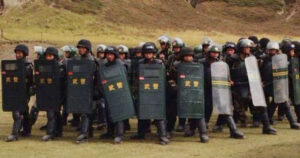 Gyajin, 44, a Tibetan father of three was arrested by Chinese police in April, along with other Tibetans, in Driru in the traditional province of Kham on suspicion of contacting Tibetans in exile through social media or by phone. Neither the whereabouts of Gyajin, nor any details of other Tibetans arrested along with him, are known due to the communication restrictions currently in place in Driru.
Gyajin, 44, a Tibetan father of three was arrested by Chinese police in April, along with other Tibetans, in Driru in the traditional province of Kham on suspicion of contacting Tibetans in exile through social media or by phone. Neither the whereabouts of Gyajin, nor any details of other Tibetans arrested along with him, are known due to the communication restrictions currently in place in Driru.
A report by Tibet Watch, a UK -based organisation who’s core aim is to promote the human rights of the Tibetan people through monitoring, advocacy and research, said that Tibetans in Driru County continue to live under a “deepening state of fear” which prevents them from sharing information on social media or keeping in touch with Tibetans outside Tibet. Restrictions and surveillance in the county have surged since local Tibetans there staged a protest against Chinese affiliated companies carrying out extraction activities on their sacred mountain, Naglha Zamba in 2010 and 2013.
Since the anti-mining protest, many Tibetans have been arrested and the place has become “the most severely and militarily controlled” place in the Tibet Autonomous Region. Tibetans living in exile who have families and relatives in Driru are left without any contact or means of communication. Those who do manage to contact people are unable to get information about the situation because of their fears of repercussions from leaking information outside.
The situation in Driru remains critical.
In August 2020, Lhamo, 36, a nomad and mother of three from Driru, died from injuries sustained during her detention; she had been arrested for sending money to her family in India,and also for keeping photos of His Holiness the Dalai Lama in her home. Her nephew, Tenzin Tharpa, was also detained for sending money to his family in exile.
 Tibet Watch say that Driru county is a rural place with a nomadic population and rich natural resources in their report Driru County: The New Hub of Tibetan Resistance.The Gyalmo Ngulchu river [English: Salween] flows through the county and despite controversy and campaigns over the years, a dam has been build. In 2013, Chinese government-linked companies arrived in Driru to carry out work on Naglha Zamba mountain in the name of “road and hydroelectric power construction project”. Local Tibetans have observed and reported that trucks of stones from their sacred mountain are being driven away under cover of night, giving rise to the suspicion that the Chinese workers were constructing a mine – either in addition to the dam or instead of the dam –prompting a protest gathering at the site. On May 24, 2013, over 3,500 Tibetans came to the site to protest while more of them gathered at the town. The authorities told Tibetans that the projects are for their benefit and if they don’t let the work continue, army troops will be brought in to ensure the work is carried out.
Tibet Watch say that Driru county is a rural place with a nomadic population and rich natural resources in their report Driru County: The New Hub of Tibetan Resistance.The Gyalmo Ngulchu river [English: Salween] flows through the county and despite controversy and campaigns over the years, a dam has been build. In 2013, Chinese government-linked companies arrived in Driru to carry out work on Naglha Zamba mountain in the name of “road and hydroelectric power construction project”. Local Tibetans have observed and reported that trucks of stones from their sacred mountain are being driven away under cover of night, giving rise to the suspicion that the Chinese workers were constructing a mine – either in addition to the dam or instead of the dam –prompting a protest gathering at the site. On May 24, 2013, over 3,500 Tibetans came to the site to protest while more of them gathered at the town. The authorities told Tibetans that the projects are for their benefit and if they don’t let the work continue, army troops will be brought in to ensure the work is carried out.
“Locals responded that there were already three dams on the river, none of which benefitted the local community. They reiterated their commitment to protecting the environment and, especially, their sacred mountain. After a protracted period of negotiation and argument, the Chinese authorities agreed to halt the work and instructed the extraction company to pay compensation for the minerals which had been removed.”
The Chinese authorities have intensified the restrictions in the county by sending army troops and government officials into the region, they have also started a political re-education campaign – as part of this drive, Tibetans across Driru are forced to fly the Chinese flag from the roof of their houses.




 Print
Print Email
Email